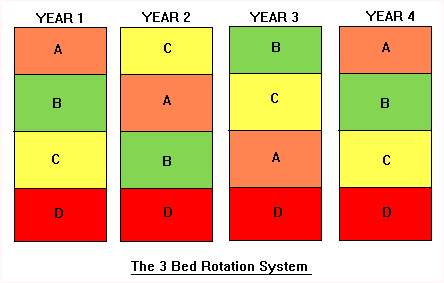Crop Rotation
Growing the same vegetables in the same spot each year can lead to problems. Soil living pests and diseases, which thrive on that particular crop, can build up in the soil to epidemic levels. Vegetables also have various mineral needs and continuous cropping of one particular crop can lead to the levels of nutrients in the soil becoming unbalanced.
To prevent the build up of pests and diseases in the soil and to help the vegetables in their nutrient needs, your crops need to be rotated. It is a fact that vegetables prefer to be grown in soil that has been used for a different crop previously than in soil that has been used for one of their own kind.
Vegetables have various soil and mineral needs. These needs can be broken down into 3 categories of each.
Nutrients - Heavy Feeders Medium Feeders Light Feeders
Soil - Acid Neutral Alkaline
By grouping together vegetable plants that have the same 'needs' you will be able to manage the soil better and by splitting your growing area into separate areas or beds, you can condition the soil to suit each grouping. For instance, Sweet Corn is a very heavy feeder; it likes a neutral to acid soil, a lot of nutrients and plenty of moisture. By digging in plenty of manure or compost it will help to feed the plant and retain the moisture for the plant to use. On the other hand Brassicas prefer to be grown in a more alkaline soil. It is obvious that the two will not grow in the same soil conditions, therefore one of them will suffer and give poor results. By rotating the vegetables the soil can be brought into a condition to suit both their needs.
The 3 Bed System
The most common system used is the '3 Bed' rotation system. This name is slightly confusing though as the system actually uses 4 beds.
Basically you are divide the growing area into four sections or beds. They would then be treated as follows: -
The First Year.
Bed 'A'
Dig over as normal and feed with a general fertiliser such as Bonemeal, or, if you want to be organic, Blood, Fish and Bone. You would then plant all the root crops in this bed. This includes Beetroot, Carrots, Jerusalem Artichokes, Parsnips, Salsify, Scorzonera.
Bed 'B'
Dig over as normal and then apply a general fertiliser as above. Depending on the pH of the soil, which you are advised to check (see soil pH section) you would apply the necessary amount of lime. In this bed you would plant all your Brassicas which include Cabbages, Broccoli, Cauliflowers, Brussels Sprouts, Kale, Radish, Swede, Turnips, Kohl Rabi.
Bed 'C'
Dig as much manure or compost as you can into this bed over the winter or very early spring. Approximately 2 weeks before planting, feed with a general fertiliser. In this bed you will plant the very heavy feeders such Potatoes, Beans, Peas, Celery, Sweet Corn, Marrows, Courgettes, Spinach, Outdoor Tomatoes, Leeks and Cucumbers.
Bed 'D'
This bed is the anomaly in the system. Great thought will have to be given in the siting if this bed initially as it will contain ALL your permanent crops. These will include Rhubarb, Strawberries, Raspberries, all fruit bushes and all fruit trees. If starting your plot from scratch, it is wise to thoroughly prepare this bed before planting as it is not going to be rotated like the other 3 beds and is going to be there for a long time. It is for this reason that the system is only referred to as a 3 Bed System.
The Second and Third Years
In the following years the system moves the beds along in rotation as follows: -

In the fourth year the system is back to where you began.
Other Systems
The 3 bed system is not the only system of Rotation. Where space is available a 4 bed system can be used. This is basically the same as the 3 Bed system except the 4th bed is not used at all and left fallow. This is only a viable proposition if you have plenty of space and can afford to let the ground lie idle for a season.
Some gardeners have even more complex systems where they use 5 or 6 beds.
The Five Year system theory is:
First Year: Potatoes. They need lots of manure, which helps to feed the fertility for the rest of the cycle. Grow outdoor tomatoes here.
Second Year: Leeks, onions. Another group needing lots of manure or compost. Also include squashes (pumpkin, Courgettes, Marrows) in this area because they have similar needs.
Third Year: Legumes - Peas and beans. Also grow sweetcorn with this group again because they have similar needs. They also fix Nitrogen in the soil ready for the next crop.
Fourth Year: Brassicas - Cabbages, sprouts, cauliflowers, broccoli, turnips, Swedes, radishes. They get the benefit of the nitrogen fixed in the soil by the legumes.
Fifth Year: Roots - carrots, parsnip, Beetroot, celeriac.
Lettuce and salad crops are used as catch crops wherever there is a spare space.
The Six Bed System
This scheme is based on Lawrence D. Hills rotation scheme using their
Natural orders. This may sound complicated but in practice it is not.
1. ROOTS: Carrot, parsnip, Beetroot, chicory, spinach beet, chard, and celeriac
2. ALLIUMS: Onions, garlic, leeks, and shallots.
3. LEGUMES: Broad beans, runner beans, French beans, peas
4. BRASSICAS: Cabbage, cauliflower, sprouts, broccoli, Swede.
5. SOLANACEAE: Potatoes, tomatoes
6. CUCURBITEAE: Courgettes, Squashes, and (Sweetcorn)
Salad crops can be fitted in around the others as catch crops.
All this may sound very simple in theory but, in practice, it tends to be a bit more difficult, especially if space is at a premium.
The average gardener will probably need a lot more space for things like Potatoes and Sweet Corn than for Beetroot. It may be that you can only erect a frame for climbing beans in a particular area to avoid it shading other crops or it is not possible to move it each year.
These plans are only a guides really and do not have to be adhered to strictly. As long as soil is well prepared each year for the necessary crop there is no reason why you cannot grow beans in the same position for a few years on the run. The only vegetables to avoid growing in the same area each year are Brassicas. These are very susceptible to Clubroot Disease. This disease is spread by spores in the soil and if given chance to build up, can devastate a crop.
© copyright 1999, P. A. Owen

